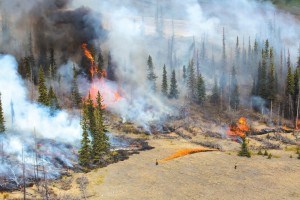
Being a member of the Parks Canada fire management team is one of the “hottest” jobs around this season. It got even hotter this week as the team began work in the Jackladder Complex and Vine Creek prescribed fire units in Jasper National Park.
Ever wonder how much area the team has to cover during these prescribed fires?
The Jasper townsite is approximately 250 hectares. In comparison, the sub-unit of the Jackladder Complex is 111 hectares, while 500 hectares remains to be burnt in the 725-hectare Vine Creek unit; 225 hectares has already been burnt.
Travellers on Highway 16 might have noticed some smoke on the slopes of Mt. Greenock in the Vine Creek unit, 20 km north of town, as fire restoration work was underway on April 19. The park’s fire crew used hand torches to burn small areas along the ridge of Mt. Greenock to help protect the endangered Whitebark pine trees, and encourage Whitebark pine colonization by restoring habitat. The burning also augments previous fireguard work to secure prescribed fire boundaries for future burning.
Prescribed fire in the Vine Creek unit will reintroduce an important natural process and its ecological benefits back to an area that historically would have burned on a frequent basis.
Ecological objectives include encouraging Whitebark pine colonization on mid to upper slopes, and restoring Douglas Fir savannah on the lower slopes of the unit. Once complete, it will also help to create a strategic firebreak for wildfires burning eastward, and help reduce available habitat for Mountain Pine Beetle which could affect forests outside the park.
If similar weather conditions persist, the team may soon have a window of opportunity to carry out further, larger-scale burning in the Vine Creek prescribed fire unit.
Earlier this week, the team used hand-held drip torches to ignite the Jackladder sub-unit #1, which consists of 90 per cent grass, along with pockets of dead woody debris from a previous prescribed fire.
The Jackladder Complex is divided into two sub-units, where fire was previously restored in 1998 and 2000. These earlier fires helped to restore open, valley bottom grasslands which were historically present. Subsequent application of fire is necessary to continue landscape restoration and improve biodiversity of this critical grassland habitat. Grasslands are important ecosystems that support specially-adapted plants, mammals, birds and insects, and are the rarest ecotype in
Jasper National Park, making up .08 per cent of the vegetation area.
Fires will happen whether we light them or not, but prescribed fires allow us to manage smoke more effectively than wildfires because we can:
manage the fire’s size, timing and burn rate to reduce the amount and duration of smoke light during good venting conditions so smoke is dispersed into the atmosphere; and
take advantage of approaching weather to shorten the smouldering period.
The safety of people, facilities and surrounding lands is Parks Canada’s top consideration in conducting these prescribed fires. Though fire managers take measures to minimize smoke and its effects, smoke during burning is inevitable.
Advance notice is provided to interested local and regional public, health authorities, identified smoke sensitive individuals, businesses, agencies and media, and will include expected locations, timing and duration of smoke.
To receive bi-annual Fire and Vegetation Management newsletters, information on prescribed fires and wildfires, and more, contact Kim Weir, fire communications specialist at [email protected].
Parks Canada
Special to the Fitzhugh
